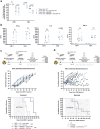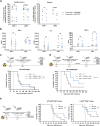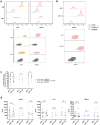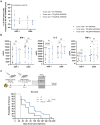TIGIT blockade in the context of BCMA-CART cell therapy does not augment efficacy in a multiple myeloma mouse model
- PMID: 40652308
- PMCID: PMC12258171
- DOI: 10.1080/2162402X.2025.2529632
TIGIT blockade in the context of BCMA-CART cell therapy does not augment efficacy in a multiple myeloma mouse model
Abstract
BCMA-directed CAR-T therapies have shown promising results in multiple myeloma (MM). However, patients continue to relapse. T cell exhaustion with increased TIGIT expression is a resistance mechanism which was confirmed in CAR-T cells from ARI0002h trial, an academic CAR-T developed in our institution. We aimed to analyze the impact of blocking TIGIT on the efficacy of ARI0002h. We used three different strategies to block TIGIT: (1) Addition of an external blocking anti-TIGIT-antibody (Ab), (2) Modify ARI0002h into a 4th generation CAR-T, named ARITIGIT, capable of secreting a soluble TIGIT-blocking scFv and (3) TIGIT knock-out in ARI0002h using CRISPR/Cas9. Each strategy was evaluated in vitro and in vivo. Adding a TIGIT-blocking Ab to ARI0002h improved in vitro cytotoxicity, but failed to enhance mice survival. The new 4th generation CAR-T, ARITIGIT, was also unable to achieve better survival outcomes despite favoring the in vivo model by using a myeloma cell line with high expression of the TIGIT ligand PVR. Interestingly, when mice were challenged with a second infusion of tumor cells, mimicking a relapse model, a trend for improved survival with ARITIGIT was observed (p = 0.11). Finally, TIGIT-knock-out on ARI0002h (KO-ARI0002h) using CRISPR/Cas9 showed similar in vitro activity to ARI0002h. In an in vivo stress model, TIGIT KO-ARI0002h prolonged survival (p = 0.02). However, this improvement was not significant compared to ARI0002h (p = 0.07). This study failed to demonstrate a significant benefit of TIGIT-blockade on ARI0002h cells despite using three different approaches, suggesting that targeting a single immune checkpoint may be insufficient.
Keywords: 4th generation CAR-T; BCMA-CAR-T; CAR-T cell therapy; CRISPR/Cas9; TIGIT blockade; multiple myeloma.
Conflict of interest statement
AOC declares no conflict of interest. JMP declares no conflict of interest. AMB declares no conflict of interest. LPA declares being one of the inventors of ARI0002h. MB declares no conflict of interest. HC declares no conflict of interest. MC declares no conflict of interest. JC declares no conflict of interest. SVS declares no conflict of interest. MBo declares no conflict of interest. OC declares no conflict of interest. DFM declares no conflict of interest. LGRL declares receiving honoraria and travel grants from Janssen, Amgen, BMS, GSK, Menarini, and Sanofi. EL declares no conflict of interest. LR declares honoraria from Janssen, BMS/Celgene, Amgen, Takeda, Sanofi, and GSK; participation on data safety monitoring or advisory board of Janssen, BMS-Celgene, Amgen, Takeda, Sanofi, and GSK. MJ declares receiving research or travel support by Fundació Bancaria la Caixa, ISCIII, and CellNex Teleom; honoraria from educational activities, speaker, and advisory roles with Miltenyi and indirectly with sponsors of congresses; and participation on data safety monitoring or advisory boards with MAB Gyala. BMA declares being one of the inventors of ARI0002h. CFL declares receiving grants through his institution from BMS, GSK, Janssen, and Amgen.
Figures





Similar articles
-
IL-18-secreting multiantigen targeting CAR T cells eliminate antigen-low myeloma in an immunocompetent mouse model.Blood. 2024 Jul 11;144(2):171-186. doi: 10.1182/blood.2023022293. Blood. 2024. PMID: 38579288 Free PMC article.
-
Anti-GPRC5D CAR T-cell therapy as a salvage treatment in patients with progressive multiple myeloma after anti-BCMA CAR T-cell therapy: a single-centre, single-arm, phase 2 trial.Lancet Haematol. 2025 May;12(5):e365-e375. doi: 10.1016/S2352-3026(25)00048-1. Epub 2025 Apr 12. Lancet Haematol. 2025. PMID: 40228504 Clinical Trial.
-
Current Anti-Myeloma Chimeric Antigen Receptor-T Cells: Novel Targets and Methods.Balkan Med J. 2025 Jul 1;42(4):301-310. doi: 10.4274/balkanmedj.galenos.2025.2025-4-25. Balkan Med J. 2025. PMID: 40619794 Free PMC article. Review.
-
Myeloma cell-intrinsic ANXA1 elevation and T cell dysfunction contribute to BCMA-negative relapse after CAR-T therapy.Mol Ther. 2025 Jul 2;33(7):3375-3391. doi: 10.1016/j.ymthe.2025.03.001. Epub 2025 Mar 8. Mol Ther. 2025. PMID: 40057828
-
Chimeric antigen receptor (CAR) T-cell therapy for people with relapsed or refractory diffuse large B-cell lymphoma.Cochrane Database Syst Rev. 2021 Sep 13;9(9):CD013365. doi: 10.1002/14651858.CD013365.pub2. Cochrane Database Syst Rev. 2021. PMID: 34515338 Free PMC article.
References
-
- Martin T, Usmani SZ, Berdeja JG, Agha M, Cohen AD, Hari P, Avigan D, Deol A, Htut M, Lesokhin A, et al. Ciltacabtagene Autoleucel, an anti–b-cell maturation antigen chimeric antigen receptor T-Cell therapy, for relapsed/refractory multiple myeloma: CARTITUDE-1 2-year follow-up. J Clin Oncol. 2023. Feb 20;41(6):1265–1274. doi: 10.1200/JCO.22.00842. - DOI - PMC - PubMed
-
- Oliver-Caldés A, González-Calle V, Cabañas V, Español-Rego M, Rodríguez-Otero P, Reguera JL, López-Corral L, Martin-Antonio B, Zabaleta A, Inogés S, et al. Fractionated initial infusion and booster dose of ARI0002h, a humanised, BCMA-directed CAR T-cell therapy, for patients with relapsed or refractory multiple myeloma (CARTBCMA-HCB-01): a single-arm, multicentre, academic pilot study. Lancet Oncol [Internet]. 2023;24(8):913–924. 10.1016/S1470-2045(23)00222-X. - DOI - PubMed
MeSH terms
Substances
LinkOut - more resources
Full Text Sources
Medical
Research Materials
